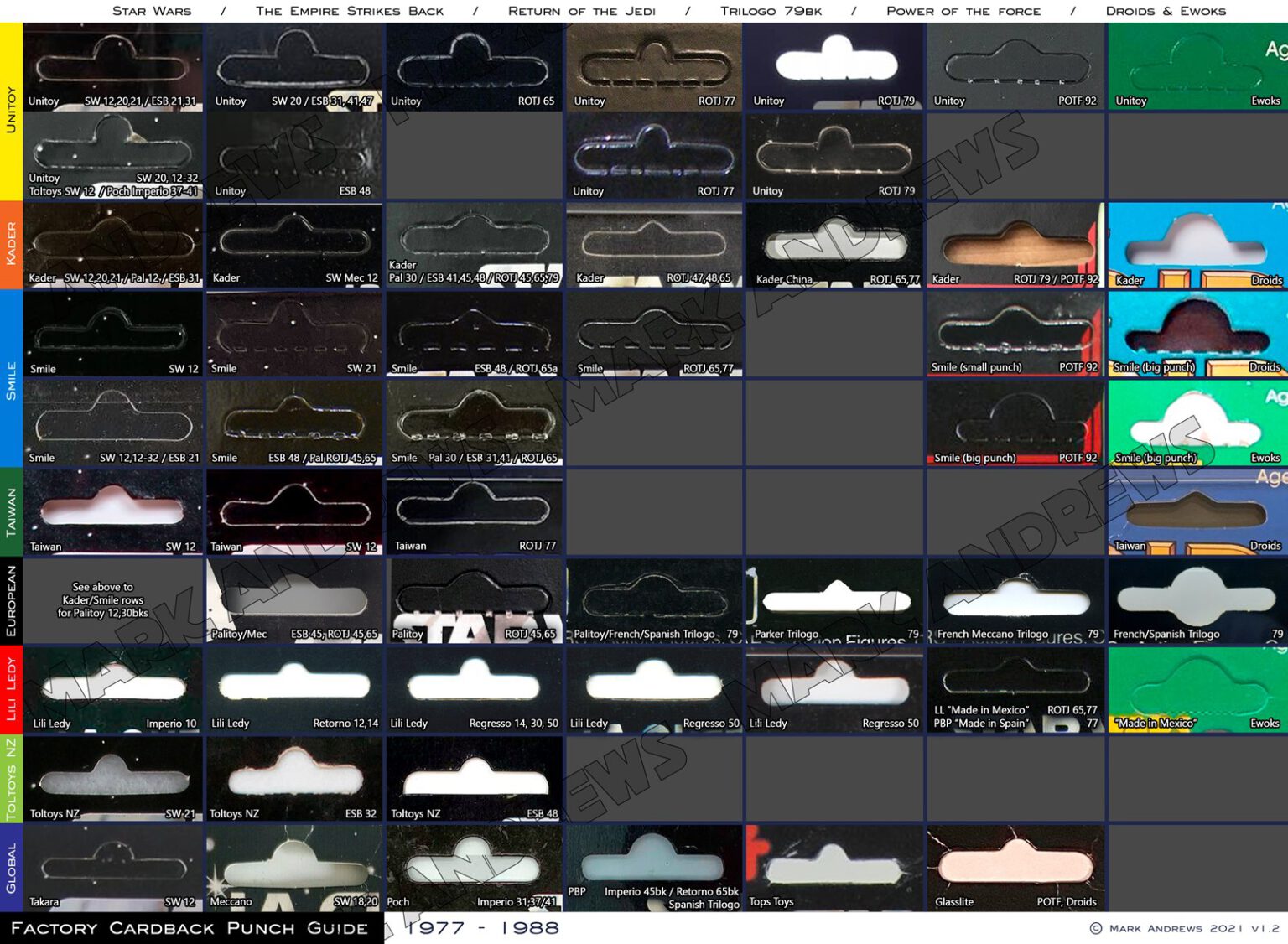Cardback Punch Guide

Chihuahua
TABLE OF CONTENTS
CARDBACK PUNCH GUIDE
This graphic is a work in progress. There WILL be missing punches, and I will update the graphic as they’re sent to me. Thx – Chihuahua.
Cardback & Punch Overview
Each vendor has a unique cardback punch (or hanger tab) which I’ve outlined on the graphic above. All of the SW and the early to mid era ESB cardbacks don’t feature a factory code on the back of the card, so identifying the vendor of a cardback by the factory punch is the only means possible.
Even though the punch shapes evolved slightly over the vintage years, there is a general rule of thumb regarding the shape which can be applied to the punches for each vendor. These rules apply up until the large circular type punches found in the later Trilogo/POTF era.
- Unitoy are known for their larger, “domed” punch. Perforations appear midway in the ESB era.
- Kader has a small domed hanger and longer shape. No perforations.
- Smile has a smaller, slightly triangular shape to their punch, with heavy perforations along the lower part of the tab (No perforations on the earliest version)
- Taiwan is very similar to Smile, just without the perforations.
From the outset, Kenner planned to have figures produced in parallel at multiple factories. Looking at the “Early Bird” sets, it seems the production of the figures run of figures was from the Kader and Unitoy vendors in Hong Kong, with a Taiwan based factory supplementing the extra demand for a few select characters. A third Hong Kong based vendor called Smile was also brought into the fold to help keep up with demand for the Star Wars toy line.
There is a consistency between the figures and cardbacks with a waffle patterned seal on the bubble. This waffle detail is important to confirm a MOC was assembled at a single source. Smooth sealed cardbacks exist in low numbers that contain mixed up figures and cardback combinations. This suggests there was also repackaging of figures away from their point of manufacture. Speculating, these might be overstock figures, surplus baggies or figures from outdated MOCs that were repackaged.
Cardbacks were die-cut in multiples, so there can be very minor variations found in the punches shown in the above graphic.
Generally speaking, international licenses such as Meccano (France), Harbert (Italy), Toltoys (Australia) and Kenner Canada imported the MOCs directly from Asia. The cardbacks were produced locally to the Asian vendors with the card design modified to include the branding and details for each license. Palitoy (UK) in the earliest period from 12 to 45a imported pre-assembled MOCs from the far east. From 45b onwards, Palitoy used both a mix of either UK and HK printed cards for each new release. Meccano, in a slightly later wave, produced their own unique 18 & 20 back cards which were also paired with imported Asian figures.
Takara in Japan had two short lived periods during the SW era. One was importing Asian packaged figures & cardbacks, which were then stickered before distribution. Secondly, a short spell of producing three unique figures which were sculpted, shot and packaged all in Japan, with Takara artwork and a different punch.
Poch also imported Asian produced figures for their earliest ESB 31bk cards, before moving into their second era of producing figures from imported a mix of Kader and Unitoy parts and accessories. Toltoys NZ produced their own cardbacks.

